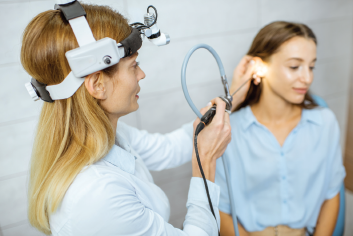I’ve had patients who would have needed a retroauricular approach to their perforation using a microscope who did not want surgery. But when they found that endoscopic tympanoplasty was an option, they were much more amenable to proceeding. —Mary Ashmead, MD
Explore This Issue
May 2020
“There has been a clear shift in the area of interest away from diagnostic endoscopy, to endoscope-assisted surgery, and lately, to transcanal endoscopic ear surgery (TEES),” researchers wrote.
EES Best Practices
Brandon Isaacson, MD, associate professor of otolaryngology–head and neck surgery, and Walter Kutz, MD, professor of otolaryngology and neurological surgery, both at the University of Texas Southwestern Medical Center, were two of the earlier adopters of EES in the U.S.
Their practices focus exclusively on otology, including treatment of chronic otitis media. After their neurotology fellowship, they used traditional microscope techniques for this treatment. But in the early 2010s, they began seeing publications on TEES out of Europe, Asia, and the Middle East, and their interest was piqued. Dr. Isaacson took an EES course in Toronto and brought the technique to UT Southwestern.
“When I went in, I was a little bit skeptical—we wanted to see if it provided any additional benefit over what otology has been doing for the past 40 years,” Dr. Isaacson said. “Once I completed the course in Toronto, I felt like it was something I wanted to offer to our patients.” Dr. Isaacson helped Dr. Kutz develop his own TEES skills, and now they both offer TEES for appropriate patients, as well as teaching the technique to others. In November 2019, they hosted the second annual TEES course at UT Southwestern—the same one Dr. Ashmead attended.

© RossHelen / shutterstock.com
Drs. Isaacson and Kutz readily agree that it takes some time and effort to learn EES but say that it is a procedure that doctors can typically become comfortable with fairly quickly.
“We hadn’t picked up an endoscope in, perhaps, 10 years—since residency,” Dr. Isaacson said. “That sounds like a big leap of faith. But honestly the steps of the surgery really don’t differ that much. There are a few nuances to it, but it wasn’t that difficult to pick up.”
Dr. Isaacson said the main focus should be positioning the endoscope to give an optimal view. “Normally you operate with two hands in ear surgery—you have to adapt to operating with one hand. There’s definitely a learning curve with it, and I think it’s harder than microscopic surgery in some ways, because you’re missing your non-dominant hand to help out.”
Dr. Kutz said that despite their limited recent experience with the endoscope, their extensive knowledge of ear surgery made EES a feasible progression in their practice. “We’re experienced ear surgeons, and the endoscope is just a different way of viewing anatomy,” he said. “It varies from person to person, but I think most otolaryngologists are going to be experienced using endoscopes. As long as you have some experience with endoscopes, I don’t think it’s that challenging to learn endoscopic ear surgery.” In addition, he said that many residents who have recently graduated tend to prefer using the endoscope.
Experienced TEES surgeons say that there should be a logical progression in the types of procedures a physician performs using an endoscope when first starting out. Dr. Isaacson suggests starting with an ear tube and then progressing to small central tympanic membrane perforations. After that, repairs of larger perforations can be performed, followed by cholesteatoma.
Dr. Isaacson also suggests having the microscope available as a backup option. “When we first started, we’d have the microscope prepped and ready to go so if we felt that anything was questionable or there were any challenges, we could always switch.” For certain procedures, such as extensive cholesteatomas or if the disease involves the mastoid, a microscope is still needed.